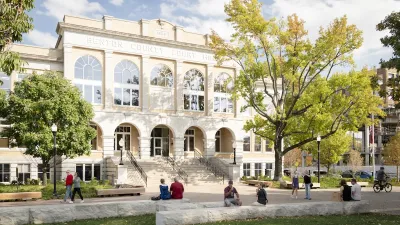The prevailing wisdom is that as a neighborhood gentrifies, long-time, low income residents are forced to move out because of rising rents, i.e. displacement. Two studies from Columbia University and the Federal Reserve draw different conclusions.

NPR News investigative correspondent Laura Sullivan "has cast a light on some of the country's most disadvantaged people." In this piece, which you can listen to as well as read, she reports from a changing, "gentrifying" if you will, neighborhood in the District of Columbia. And that means poor people are being forced out, right?
Lance Freeman, the director of the Urban Planning program at Columbia University [and Planetizen blogger], says that's what he believed was happening, too. He launched a study, first in Harlem and then nationally, calculating how many people were pushed out of their homes when wealthy people moved in.
His findings surprised even him. "(P)eople in neighborhoods classified as gentrifying were moving less frequently", he states. "Freeman's work found that low-income residents were no more likely to move out of their homes when a neighborhood gentrifies than when it doesn't," Sullivan writes.
"That squares with a recent study by the Federal Reserve Bank of Cleveland," writes Sullivan.
"We're finding that the financial health of original residents in gentrifying neighborhoods seems to be increasing, as compared to original residents in nongentrifying, low-priced neighborhoods," says Daniel Hartley, a research economist with the bank.
"He says higher costs can push out renters, especially those who are elderly, disabled or without rent-stabilized apartments. But he also found that a lot of renters actually stay — especially if new parks, safer streets and better schools are paired with a job opportunity right down the block," writes Sullivan.
Read here the results of a recent survey about who benefits from redevelopment in neighborhoods in the District. More findings from the Federal Reserve study can be found here.
FULL STORY: Gentrification May Actually Be Boon To Longtime Residents

Alabama: Trump Terminates Settlements for Black Communities Harmed By Raw Sewage
Trump deemed the landmark civil rights agreement “illegal DEI and environmental justice policy.”

Study: Maui’s Plan to Convert Vacation Rentals to Long-Term Housing Could Cause Nearly $1 Billion Economic Loss
The plan would reduce visitor accommodation by 25% resulting in 1,900 jobs lost.

Why Should We Subsidize Public Transportation?
Many public transit agencies face financial stress due to rising costs, declining fare revenue, and declining subsidies. Transit advocates must provide a strong business case for increasing public transit funding.

Paris Bike Boom Leads to Steep Drop in Air Pollution
The French city’s air quality has improved dramatically in the past 20 years, coinciding with a growth in cycling.

Why Housing Costs More to Build in California Than in Texas
Hard costs like labor and materials combined with ‘soft’ costs such as permitting make building in the San Francisco Bay Area almost three times as costly as in Texas cities.

San Diego County Sees a Rise in Urban Coyotes
San Diego County experiences a rise in urban coyotes, as sightings become prevalent throughout its urban neighbourhoods and surrounding areas.
Urban Design for Planners 1: Software Tools
This six-course series explores essential urban design concepts using open source software and equips planners with the tools they need to participate fully in the urban design process.
Planning for Universal Design
Learn the tools for implementing Universal Design in planning regulations.
Smith Gee Studio
Alamo Area Metropolitan Planning Organization
City of Santa Clarita
Institute for Housing and Urban Development Studies (IHS)
City of Grandview
Harvard GSD Executive Education
Toledo-Lucas County Plan Commissions
Salt Lake City
NYU Wagner Graduate School of Public Service





























